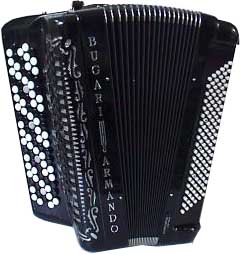Accordion/Right hand (Chromatic button accordion)

A chromatic button accordion is a type of button accordion where the right side keyboard has rows of buttons arranged chromatically. They have three to five (rarely, some Serbian accordions have six) diagonal rows. Each row can play successive chromatic notes.


Chromatic accordions are most popular in Europe and in Russia. In Russia, this instrument is usually called a "bayan" (in Russian: баян).
There are two main types of button accordions. In both types, the further away from the top of the keyboard you go, the higher the notes; the closer to the top, the lower.
Both systems are mirrors of each other, as you can see by the chart to the left. In the "C system" accordion, the middle "C" is on the row furthest to the right. In the "B system", the "C" is located on the third row from the right. The B system is primarily played in Eastern Europe, Russia, and Norway, while the C system is found mostly in Western Europe, with exceptions.
Most chromatic accordions have two extra rows located to the left of the main rows. They play the same notes as the same buttons of the 1st and 2nd rows. This can be helpful when playing a difficult melody, because you do not have to change fingerings when playing in a different key, but only move your hand to the left a row or two and play with the same fingering.
Chromatic accordions have a much larger range than their piano equivalents (they generally go a seventh higher and up to an octave lower). Also, it is possible to use the same fingering for playing almost any melody in any key - whereas on the keyboard, you have to learn twelve individual fingerings; one for each of the twelve keys. Because the notes are positioned much closer together, large leaps and stretches are easier (you can easily stretch two octaves, compared to about a tenth or twelfth on a piano accordion). For these reasons, many professionals prefer playing button instruments. However, depending on where you live, they may be hard to find (in Australasia and North America, they are particularly rare, and even then usually only available in "C system"). Note that this book does not currently cover playing on the button accordion.
